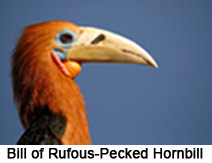 Rufous-Necked Hornbill is an Indian bird that bears a scientific name "Aceros nipalensis" widespread in Indian states and Nepal. Rufous-Necked Hornbill is a large hornbill with distinctive rufous head and under parts. The male Rufous-Necked Hornbills are black above with white-tipped outer primaries, white tail with black basal half, pale yellowish bill with row of vertical dark ridges on upper mandible and almost no casque, blue orbital skin and red gular skin. The female Rufous-Necked Hornbill has black head, neck and under parts and slightly duller orbital skin.
Rufous-Necked Hornbill is an Indian bird that bears a scientific name "Aceros nipalensis" widespread in Indian states and Nepal. Rufous-Necked Hornbill is a large hornbill with distinctive rufous head and under parts. The male Rufous-Necked Hornbills are black above with white-tipped outer primaries, white tail with black basal half, pale yellowish bill with row of vertical dark ridges on upper mandible and almost no casque, blue orbital skin and red gular skin. The female Rufous-Necked Hornbill has black head, neck and under parts and slightly duller orbital skin.
Population of Rufous-Necked Hornbill
Rufous-Necked Hornbill is estimated that there are now less than 10,000 adults remaining. With a length of about 117 centimetres (46 in), it is among the largest Bucerotine hornbills. The under parts, neck and head are rich rufous in the male, but black in the female.
Structure of Rufous-Necked Hornbill
Rufous-Necked Hornbill has the head, neck, and lower body of the male coloured rufous, with deeper colouration on the flanks and abdomen. The middle primaries and the lower half of the tail are tipped white. The rest of the hornbill`s plumage is glossy dark-green and black. The lower tail-covert feathers are coloured chestnut mixed with black.
Gender of Rufous-Necked Hornbill
The female Rufous-Necked Hornbill, on the other hand, is black, except for the end-portion of her tail and the tips of the middle primaries, which are white. The juvenile Rufous-Necked Hornbill resembles adults of the same sex, but lacks the ridges at the base of the upper beak.
 Beak of Rufous-Necked Hornbill
Beak of Rufous-Necked Hornbill
The beak of Rufous-Necked Hornbill lacks a true caique but is thickened at its base. It has a number of dark ridges on the upper beak which are absent in the young and increase in number with age up to about seven. The commissure of the beaks is broken for both sexes.
Concentration of Rufous-Necked Hornbill
Rufous-Necked Hornbills fly from Nepal to Vietnam, but which is now restricted to north-eastern India, Bhutan, Burma, South-eastern Tibet, northern and western Thailand, northern Laos and northern Vietnam.
Nests of Rufous-Necked Hornbill
The nesting period of Rufous-Necked Hornbill is from March to June. The trees being preferred are tall and having broad girths. There is evidence to suggest that the rufous-necked hornbill communities" move seasonally between one forested areas to another to avail the differing abundance of fruiting trees due to local conditions.











